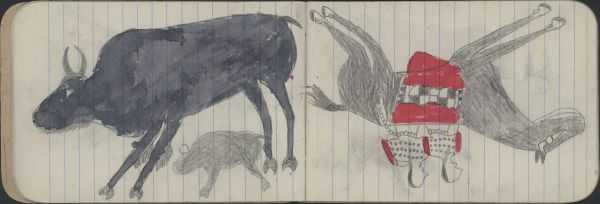ANIMALS, BUFFALO: Female Buffalo and Calf; COURTING:2 Women in Elk Teeth Dresses Ride Dark Horse
Ethnographic Notes
18 A large buffalo cow and calf are depicted moving from right to left across the page. The cow arches over the calf, which is under her. Fringed beard and forelegs on the adult is apparent: horns, tail, and the split hooves. The eye is an unpigmented circle, contrasting with the hide. This image is repeated almost exactly in PILA Plates 11-17. In none of these does the calf have eyes represented. One of the outstanding characteristics of Wild Hog's ledgers is the occurrence of numerous female animals with young: bears, elk, turkey, and bison. The ledgers were created during the spring season, February to July, during spring of 1879. The proper name for the animal is �bison,� but popular usage at the time was �buffalo��it is hard to imagine the Bison Bill Show. Buffalo were a major food source of Cheyenne people not long after they acquired horses, about 1750 (Weist, A History of the Cheyenne People, 1977: 19), and certainly by the 19th century, when "Buffalo provided their mains subsistence; meat was boiled, roasted, or dried for storage" (Weist, 1977: 32). Its hide provided shelter, clothing, tools, and utensils. When Northern Cheyenne men incarcerated in the Ford County, Kansas jail in 1879 drew these pictures, the herds were declining rapidly. The animal remained important as a supernatural being: "For all Algonkian-speaking peoples, including the Cheyennes, buffalo are believed to be owned by the subterranean Powers" (Cowdrey, 1999: 85). At Ludlow Cave in South Dakota exists an 18th century Cheyenne petroglyph of "Esevon, Mother of All the Buffalo. A newborn calf is protected between her legs . . . ." (Cowdrey, 1999: 86, Figure 31). The similarity of the female buffalo with calf images in this ledger compared to the petroglyph is striking in subject matter; composition (small calf between cow's legs); detailing of split hooves, ears, and horns; and proportion. Cowdrey also notes the continuity of the petroglyph images in later glyphic motifs as he compares the incised buffalo hooves with those on shield designs in Arrow's Elk Society Ledger (plates 27 and 165). They resemble the hooves on these animals. Media: The female bison is outlined in pencil and filled with black ink. The calf is drawn with lead pencil outline and fill. 19 reversed Two formally dressed women sit atop a dark horse. The horse runs from right to left across the page. The two women wear dresses with elk teeth trim, red sleeves, and white bodices. Elk teeth dresses were rare. Only certain molars of the elk were used, and each animal had two. The rows of teeth indicate men in their family successfully hunted the large animals and saved teeth for them. A photograph of an elk teeth dress is in Cowdrey (1999: 171).The women both have nickel-silver concho belts, with the end showing on the first woman (Petersen, 1983: 287). Their shared blanket is red with a beaded strip; it is the Lakota courting blanket style, with a beaded medicine wheel (Powers, 1980: 40-7). The two women could be sisters, cousin-sisters (maternal first cousins), or very close friends (Cowdrey describes 'nisson' relationships of this nature, and their connection to courting groups, 1999: 197). They may be on a courting outing together, dressed in their finest. They ride a gray horse with white hooves and silver headstall. Candace Greene discusses the "range of situations" that suggest implications of courtship context (1996: 29; see Plate 8 discussion). See plate 1 for further discussion of courtship conventions. Media: lead pencil outline, details, and fill; red watercolor


